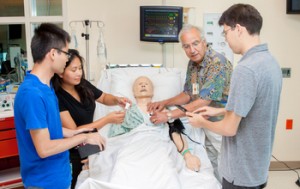A new cardiac stethoscope funded by the National Science Foundation (NSF) helps doctors detect heart failure more effectively than ever before.
Despite advances in medicine that make many heart conditions treatable, the absence of effective, early diagnosis often leads to sudden, unexpected deaths. Annually more than one million patients are hospitalized due to heart failure and the cost of health care services, medications to treat heart failure etc. are tremendous. Furthermore most of the patients get readmitted to hospitals within 30 days of their initial discharge. This new type of stethoscope will prompt significant and positive changes for patients suffering from heart failure and other related conditions.
The device attaches to the body surface much like an EKG sensor. It is non-invasive, meaning there is no need to implant it anywhere in the body. It uses a novel radio frequency (RF) sensor to detect small changes in lung water, and monitor vital signs including heart and respiration rate, and stroke volume. The device uses low level RF signals, two-thirds lower than the average cell phone signal. If the lungs have too much water, the magnitude of the microwave signal gets weaker.
Today a reliable, low-cost, non-invasive method to measure changes that occur in the water content of the lungs does not exist. Having such a device could be an important tool for the early detection of heart failure, which afflicts an estimated 5.1 million Americans.
In hospitals, the stethoscope could be an important component to monitor patients after discharge to prevent readmission especially because the hospitals are now penalized when patients come back with heart failure within 30 days. Patients could potentially benefit from the new technology for heart failure and also other symptoms like edema, emphysema, dehydration, blood infection, acute lung injury and the effects of critical burns.
The impact of saving lives could be tremendous, particularly in the case of predicting heart failure.
It is also possible for the doctor to connect the device to the internet so that the patient will be able to measure important vital signs remotely and transmit data on a regular basis, instead of visiting the hospital frequently.
Researchers believe this new device will save lives and result in big savings to health care costs.
For more information please visit:
http://www.nsf.gov


Comments are closed.